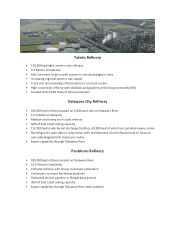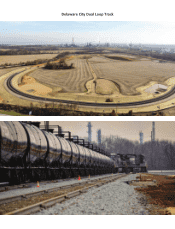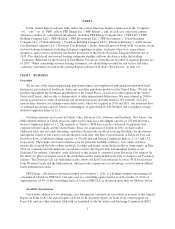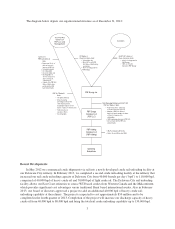PBF Energy 2012 Annual Report Download - page 13
Download and view the complete annual report
Please find page 13 of the 2012 PBF Energy annual report below. You can navigate through the pages in the report by either clicking on the pages listed below, or by using the keyword search tool below to find specific information within the annual report.
expand and upgrade the existing on-site railroad infrastructure, including the expansion of the crude rail
unloading facilities that was completed in February 2013 and is capable of discharging approximately 110,000
bpd. The project cost approximately $57.0 million, $49.7 million of which had been spent as of December 31,
2012. Also in February 2013, our board of directors approved a project to add an additional 40,000 bpd of heavy
crude rail unloading capability at the refinery. Additionally, we continue to evaluate the development of a
construction project consisting of a mild hydrocracker and hydrogen plant at the refinery. We estimate that the
construction of the project, if commenced, could take approximately three years from commencement and if
completed could process streams from both Delaware City and Paulsboro.
Overview. The Delaware City refinery is located on a 5,000-acre site, with access to waterborne cargoes and
an extensive distribution network of pipelines, barges and tankers, truck and rail. Delaware City is a fully
integrated operation that receives crude via rail at the crude unloading facility, or ship or barge at its docks
located on the Delaware River. The crude and other feedstocks are transported, via pipes, to an extensive tank
farm where they are stored until processing. In addition, there is a 17-bay, 50,000 bpd capacity truck loading rack
located adjacent to the refinery and a 23-mile interstate pipeline that are used to distribute clean products.
The Delaware City refinery has a throughput capacity of 190,000 bpd and a Nelson Complexity Index of
11.3. As a result of its configuration and process units, Delaware City has the capability of processing a heavy
slate of crudes with a high concentration of high sulfur crudes and is one of the largest and most complex
refineries on the East Coast. The Delaware City refinery is one of two heavy coking refineries, in addition to
Paulsboro, on the East Coast of the United States with coking capacity equal to approximately 25% of crude
capacity.
The Delaware City refinery processes a variety of medium to heavy, sour crude oils. The refinery has large
conversion capacity with its 82,000 bpd FCC unit, 47,000 bpd FCU and 18,000 bpd hydrocracking unit with vacuum
distillation. Hydrogen is provided via the refinery’s steam methane reformer and continuous catalytic reformer.
Delaware City Process Flow Diagram
Crude
Naphtha
Kerosene
Diesel
Coker
Middle
Distillate
Gas oil
Gas oil
Gasoline
Butane
Light
Cycle Oil
Heating Oil
ULSD
Naptha
Tetra feed
Reformate
B-B
Isobutane
P-P
(Sales)
Naphtha to HDS
Heavy
Cycle Oil
Gas oil
Gas Oil
Gas oil
ATB
VTB
Naphtha
Slurry (Sales)
Crude
Distillation
Vacuum
Distillation
Hydrotreaters
FCC
CNHTU
ISOM
CCR
Tetra
Extraction
Poly
Alky Gasoline
Benzene
Diesel
Coke
Fluid Coker Hydrocracker
SHU
5
























